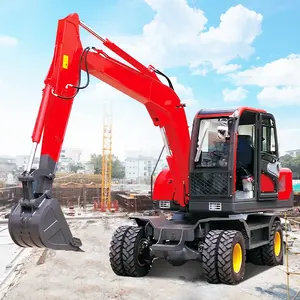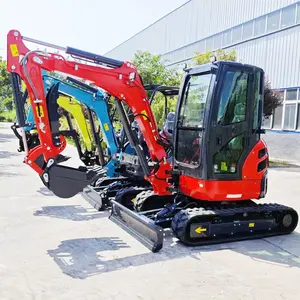
Free Shipping Farm Earthwork Hydraulic 8 Ton Wheel Digger Clamshell Shovel Agricultural Used Excavators For Sale

New Mini Excavator Prices 1.8 T 1800 Kg 2000kg 2 Ton Excavators Small Digger With CE EPA For Sale Bagger










Excavators are pieces of hefty construction equipment that comprise a boom, arm, bucket, and cab on a spinning superstructure atop a track or wheeled undercarriage. These machines are primarily utilized in various applications for digging, lifting, and carrying tasks. Excavators can complete a broader range of functions at the end of the different boom and arm configurations using special tools such as hydraulic breakers, cutters, shears, grapples, couplers, etc. Depending on the use and the desired outcome, they differ in size, such as productivity, fuel efficiency, and multi-functionality. Each size serves a specific purpose, and some are highly specialized.
Excavators are classified into several types. Crawlers are ideal for mining and heavy-duty construction jobs because they run on two large, endless tracks. On the other hand, wheeled excavators resemble crawlers in size and appearance but run on wheels rather than tracks. When tracks are replaced with wheels, the vehicle becomes faster and easier to maneuver on concrete, asphalt, and other flat surfaces while maintaining the same power capabilities. Dragline excavators are larger excavators that work differently. A hoist rope system connects to a bucket via a coupler on the equipment. Suction excavators, also known as vacuum excavators, have a suction pipe that can produce up to 400 horsepower. A suction excavator is suitable for delicate underground applications because it can reduce damage by more than 50%.
Unlike standard excavators, skid steers have booms and buckets facing the driver. They are frequently used for digging pools, site cleaning, residential work, and debris removal when space is limited and objects are widely dispersed. Long-reach excavators have more extended arm and boom sections. The design allows for more effortless operation in difficult-to-reach areas. These excavators are best suited for demolition tasks such as structural crumbling and tearing down walls over bodies of water. Mini excavators are a more compact and maneuverable version of the standard excavator designed to minimize ground damage and fit through crowded, narrow sites such as parking lots and indoor spaces. Small excavators, also known as compact excavators, typically have minimized tail-swing or zero tail-swing to maneuver tighter turns and avoid collisions with any obstacles.
Excavators have powerful engines and hydraulic systems that make them strong and capable of handling complex, heavy-duty tasks. They can dig deep into the ground, dismantle large structures, and move massive amounts of material. They are also known for their efficiency, and they can handle large amounts of material in a short amount of time. They also have high-powered hydraulic systems that allow them to work quickly and efficiently, reducing the time and labor required for a project.